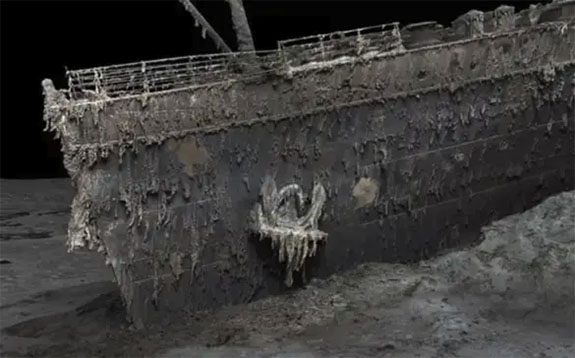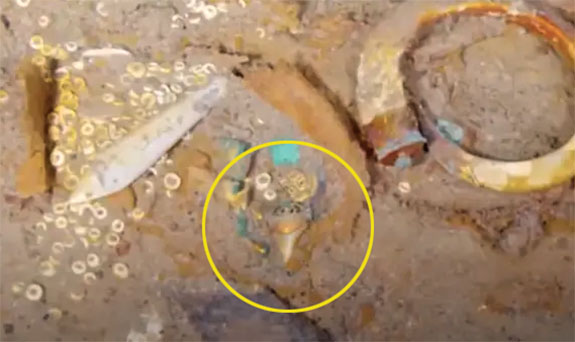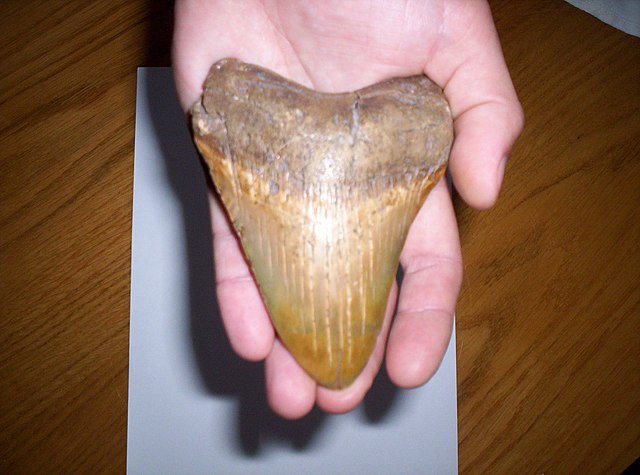May 31st, 2023
Employing a pair of submersibles named Romeo and Juliet, the Guernsey-based Magellan company took six weeks to complete the largest underwater scan in history. In the end, the high-tech firm had compiled 700,000 high-resolution images in an effort to map every millimeter of the wreck site of the ill-fated Titanic.

Magellan stitched together the images to deliver an incredibly detailed, 3D look at the 882-foot luxury liner from every angle. Its cameras were able to see minute details, from the serial number on one of the ship's propellers, to a unique piece of jewelry lost by a distinguished passenger on April 14, 1912 — the night the Titanic sank after hitting an iceberg while on its maiden voyage from Southampton, England, to New York.

At a depth of 12,500 feet, the submersibles were able to spot a turquoise and gold shark tooth necklace lying on the ocean floor in a field of white circular ornaments, possibly ivory hoops or carved beads.
But, this is not an average shark tooth necklace, according to breathless accounts infiltrating the Internet, but the tooth of a prehistoric megalodon. Really?
The extinct shark existed millions of years ago and grew to 65 feet in length, the size of one and a half school buses. It was at the top of the food chain with a bite force of between 108,514 and 182,201 Newtons. That's nearly 10 times the crunching power of a great white shark.
It also flashed enormous teeth. In fact, the name of the species is derived from the Greek, meaning "big tooth."

The problem with the premise that the scan revealed a megalodon-tooth necklace is that the giant shark's tooth measures about 7 inches from point to base — not exactly the size a jeweler would deem fit for a fashionable gold pendant. No, we're pretty sure the jewelry is set with a conventional shark tooth.
Even so, the Magellan team is reportedly using artificial intelligence to scan footage of passengers boarding the ship to see if anyone was wearing a shark-tooth necklace during the voyage. From there, they might be able to track down the ancestors of that person and potentially reunite them with the jewelry.
As for now, the Magellan team may not collect any artifacts on the ocean floor due to restrictions placed by the US and British governments.
Of the 2,240 passengers and crew on the Titanic, more than 1,500 lost their lives in the North Atlantic Ocean about 400 miles south of Newfoundland, Canada. The ship sank in two parts and the debris field spreads over three miles between the bow and stern.
Credits: Titanic screen captures via Magellan. Megalodon tooth photo by Fakirbakir, Public domain, via Wikimedia Commons.

Magellan stitched together the images to deliver an incredibly detailed, 3D look at the 882-foot luxury liner from every angle. Its cameras were able to see minute details, from the serial number on one of the ship's propellers, to a unique piece of jewelry lost by a distinguished passenger on April 14, 1912 — the night the Titanic sank after hitting an iceberg while on its maiden voyage from Southampton, England, to New York.

At a depth of 12,500 feet, the submersibles were able to spot a turquoise and gold shark tooth necklace lying on the ocean floor in a field of white circular ornaments, possibly ivory hoops or carved beads.
But, this is not an average shark tooth necklace, according to breathless accounts infiltrating the Internet, but the tooth of a prehistoric megalodon. Really?
The extinct shark existed millions of years ago and grew to 65 feet in length, the size of one and a half school buses. It was at the top of the food chain with a bite force of between 108,514 and 182,201 Newtons. That's nearly 10 times the crunching power of a great white shark.
It also flashed enormous teeth. In fact, the name of the species is derived from the Greek, meaning "big tooth."

The problem with the premise that the scan revealed a megalodon-tooth necklace is that the giant shark's tooth measures about 7 inches from point to base — not exactly the size a jeweler would deem fit for a fashionable gold pendant. No, we're pretty sure the jewelry is set with a conventional shark tooth.
Even so, the Magellan team is reportedly using artificial intelligence to scan footage of passengers boarding the ship to see if anyone was wearing a shark-tooth necklace during the voyage. From there, they might be able to track down the ancestors of that person and potentially reunite them with the jewelry.
As for now, the Magellan team may not collect any artifacts on the ocean floor due to restrictions placed by the US and British governments.
Of the 2,240 passengers and crew on the Titanic, more than 1,500 lost their lives in the North Atlantic Ocean about 400 miles south of Newfoundland, Canada. The ship sank in two parts and the debris field spreads over three miles between the bow and stern.
Credits: Titanic screen captures via Magellan. Megalodon tooth photo by Fakirbakir, Public domain, via Wikimedia Commons.



